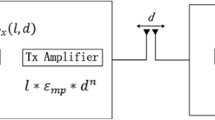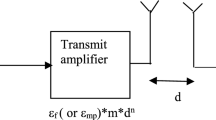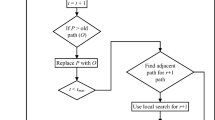Abstract
In the modern era, WSNs broadly used in many research areas. Mainly researchers are focusing on rising the network lifetime, throughput and decreasing the energy utilization to make the network more reliable, robust and more responsive for a longer period of time. In this paper, two key aspects are taken into account; (i) network lifetime (ii) throughput of the network. The proposed approach is based on multilevel heterogeneity inspired by SEP (Stable Election Protocol). First node dead in the network plays a vital role in network lifetime because if the first node dead after a long period then definitely network lifetime becomes better. To get better the network life time, the proposed approach is another effort to make the network more responsive. Proposed approach compared with NEECP (Novel Energy-Efficient clustering protocol), ICACO (Inter Cluster Ant Colony optimization) and DCHSM (Dynamic Cluster Head Selection Method) gives the improved outcome in conditions of Network lifetime and throughput. In addition to this, comparison with existing approaches is carried out by considering the research papers from the year 2000 to 2017for 16 approaches.













Similar content being viewed by others
References
Ouchitachen, H., Hair, A., & Idrissi, N. (2017). Improved multi-objective weighted clustering algorithm in wireless sensor network. Egyptian Informatics Journal, 18(1), 45–54.
Ren, J., Zhang, Y., Zhang, K., Liu, A., Chen, J., & Shen, X. S. (2016). Lifetime and energy hole evolution analysis in data-gathering wireless sensor networks. IEEE Transactions on Industrial Informatics, 12(2), 788–800.
Long, J., Dong, M., Ota, K., & Liu, A. (2017). A Green TDMA Scheduling algorithm for prolonging lifetime in wireless sensor networks. IEEE Systems Journal, 11(2), 868–877.
Nayak, P., & Devulapalli, A. (2016). A fuzzy logic-based clustering algorithm for WSN to extend the network lifetime. IEEE Sensors Journal, 16(1), 137–144.
Pananjady, A., Bagaria, V. K., & Vaze, R. (2017). Optimally approximating the coverage lifetime of wireless sensor networks. IEEE/ACM Transactions on Networking, 25(1), 98–111.
Zhou, F., Chen, Z., Guo, S., & Li, J. (2016). Maximizing lifetime of data-gathering trees with different aggregation modes in WSNs. IEEE Sensors Journal, 16(22), 8167–8177.
Fei, Z., Li, B., Yang, S., Xing, C., Chen, H., & Hanzo, L. (2017). A survey of multi-objective optimization in wireless sensor networks: Metrics, algorithms, and open problems. IEEE Communications Surveys & Tutorials, 19(1), 550–586.
Sun, Y., Dong, W., & Chen, Y. (2017). An improved routing algorithm based on ant colony optimization in wireless sensor networks. IEEE Communications Letters, 21(6), 1317–1320.
Kumar, H., & Singh, P.K. (2017). Analyzing data aggregation in wireless sensor networks, In 4th international conference on computing for sustainable global development INDIACom, pp. 4024–4029.
Kumar, H., Singh, P.K. (2017). Node energy based approach to improve network lifetime and throughput in wireless sensor networks. Journal of Telecommunication, Electronic and Computer Engineering (JTEC), 9(3–6): 79–88.
Kumar, H., & Singh, P. K. (2018). Comparison and analysis on artificial intelligence based data aggregation techniques in wireless sensor networks. Procedia Computer Science, 132, 498–506.
Kumar, H., & Singh, P. K. (2018). Power transmission analysis in wireless sensor networks using data aggregation techniques. International Journal of Information System Modeling and Design, 9(4), 49–66.
Kumar, H., & Singh, P. K. (2019). Average energy analysis in wireless sensor networks using multitier architecture. International Journal of Performability Engineering, 15(4), 1199–1208.
Kumar, H., & Singh, P. K. (2020). Network lifetime and throughput analysis in wireless sensor networks using fuzzy logic. Recent Advances in Electrical and Electronic Engineering, 13(2), 227–235.
Heinzelman, W. R., Chandrakasan, A., & Balakrishnan, H. (2000, January). Energy-efficient communication protocol for wireless microsensor networks. In System sciences, 2000. Proceedings of the 33rd annual Hawaii international conference (pp. 10-pp). IEEE.
Handy, M. J., Haase, M., & Timmermann, D. (2002). Low energy adaptive clustering hierarchy with deterministic cluster-head selection. In 4th international workshop onmobile and wireless communications network, 2002. (pp. 368–372). IEEE.
Younis, O., & Fahmy, S. (2004). HEED: a hybrid, energy-efficient, distributed clustering approach for ad hoc sensor networks. IEEE Transactions on Mobile Computing, 3(4), 366–379.
Smaragdakis, G., Matta, I., & Bestavros, A. (2004). SEP: A stable election protocol for clustered heterogeneous wireless sensor networks. Boston University Computer Science Department, pp. 1–11.
Qing, L., Zhu, Q., & Wang, M. (2006). Design of a distributed energy-efficient clustering algorithm for heterogeneous wireless sensor networks. Computer Communications, 29(12), 2230–2237.
Kim, J. M., Park, S. H., Han, Y. J., & Chung, T. M. (2008, February). CHEF: cluster head election mechanism using fuzzy logic in wireless sensor networks. In 10th international conference on Advanced communication technology, 2008. ICACT 2008. (Vol. 1, pp. 654–659). IEEE.
Taheri, H., Neamatollahi, P., Younis, O. M., Naghibzadeh, S., & Yaghmaee, M. H. (2012). An energy-aware distributed clustering protocol in wireless sensor networks using fuzzy logic. Ad Hoc Networks, 10(7), 1469–1481.
Dahnil, D. P., Singh, Y. P., & Ho, C. K. (2012). Topology-controlled adaptive clustering for uniformity and increased lifetime in wireless sensor networks. IET Wireless Sensor Systems, 2(4), 318–327.
Bagci, H., & Yazici, A. (2013). An energy aware fuzzy approach to unequal clustering in wireless sensor networks. Applied Soft Computing, 13(4), 1741–1749.
Salim, A., Osamy, W., & Khedr, A. M. (2014). IBLEACH: intra-balanced LEACH protocol for wireless sensor networks. Wireless Networks, 20(6), 1515–1525.
Kim, J. Y., Sharma, T., Kumar, B., Tomar, G. S., Berry, K., & Lee, W. H. (2014). Intercluster ant colony optimization algorithm for wireless sensor network in dense environment. International Journal of Distributed Sensor Networks, 10(4), 457402.
Tarhani, M., Kavian, Y. S., & Siavoshi, S. (2014). SEECH: Scalable energy efficient clustering hierarchy protocol in wireless sensor networks. IEEE Sensors Journal, 14(11), 3944–3954.
Jia, D., Zhu, H., Zou, S., & Hu, P. (2016). Dynamic cluster head selection method for wireless sensor network. IEEE Sensors Journal, 16(8), 2746–2754.
Balakrishnan, B., & Balachandran, S. (2017). FLECH: fuzzy logic based energy efficient clustering hierarchy for nonuniform wireless sensor networks. Wireless Communications and Mobile Computing, 2017(1), 1–13.
Zhou, Y., Wang, N., & Xiang, W. (2017). Clustering hierarchy protocol in wireless sensor networks using an improved PSO algorithm. IEEE Access, 5, 2241–2253.
Latha, A., Prasanna, S., Hemalatha, S., & Sivakumar, B. (2019). A harmonized trust assisted energy efficient data aggregation scheme for distributed sensor networks. Cognitive Systems Research, 56, 14–22.
Dattatraya, K. N., & Rao, K. R. (2019). Hybrid based cluster head selection for maximizing network lifetime and energy efficiency in WSN. Journal of King Saud University-Computer and Information Sciences.
Dietrich, I., & Dressler, F. (2009). On the lifetime of wireless sensor networks. ACM Transactions on Sensor Networks (TOSN), 5(1), 1–38.
Yildiz, H. U., Gungor, V. C., & Tavli, B. (2019). Packet size optimization for lifetime maximization in underwater acoustic sensor networks. IEEE Transactions on Industrial Informatics, 15(2), 719–729.
Movva, P., & Rao, P. T. (2019). Novel two-fold data aggregation and MAC scheduling to support energy efficient routing in wireless sensor network. IEEE Access, 7, 1260–1274.
Dutt, S., Agrawal, S., & Vig, R. (2019). Impact of variable packet length on the performance of heterogeneous multimedia wireless sensor networks. Wireless Personal Communications, 107(4), 1–15.
Redhu, S., & Hegde, R. M. (2019). Network lifetime improvement using landmark-assisted mobile sink scheduling for cyber-physical system applications. Ad Hoc Networks, 87, 37–48.
Saranraj, G., Selvamani, K., & Kanagachidambaresan, G. R. Optimal Energy-Efficient Cluster Head Selection (OEECHS) for Wireless Sensor Network. Journal of The Institution of Engineers (India): Series B, 100(4), 1–8.
Sharma, D., Ojha, A., & Bhondekar, A. P. (2018). Heterogeneity consideration in wireless sensor networks routing algorithms: a review. The Journal of Supercomputing, 75(5), 1–54.
Tabatabaei, S., Rajaei, A., & Rigi, A. M. (2019). Wireless Personal Communications. https://doi.org/10.1007/s11277-019-06497-6
Nawrocki, P., & Sniezynski, B. (2020). Adaptive context-aware energy optimization for services on mobile devices with use of machine learning. Wireless Personal Communications, 115(3), 1839–1867.
Author information
Authors and Affiliations
Corresponding author
Additional information
Publisher's Note
Springer Nature remains neutral with regard to jurisdictional claims in published maps and institutional affiliations.
Rights and permissions
About this article
Cite this article
Kumar, H., Singh, P.K. Enhancing Network lifetime and Throughput in Heterogeneous Wireless Sensor Networks. Wireless Pers Commun 120, 2971–2989 (2021). https://doi.org/10.1007/s11277-021-08594-x
Accepted:
Published:
Issue Date:
DOI: https://doi.org/10.1007/s11277-021-08594-x




